Refine listing
Actions for selected content:
17000 results
9 - Matter
- from Part III - THE REAL WORLD
-
- Book:
- Covariant Loop Quantum Gravity
- Published online:
- 05 February 2015
- Print publication:
- 13 November 2014, pp 187-194
-
- Chapter
- Export citation
6 - Bubbles and the cosmological constant
- from Part II - THREE-DIMENSIONAL THEORY
-
- Book:
- Covariant Loop Quantum Gravity
- Published online:
- 05 February 2015
- Print publication:
- 13 November 2014, pp 118-128
-
- Chapter
- Export citation
Part II - THREE-DIMENSIONAL THEORY
-
- Book:
- Covariant Loop Quantum Gravity
- Published online:
- 05 February 2015
- Print publication:
- 13 November 2014, pp 97-98
-
- Chapter
- Export citation
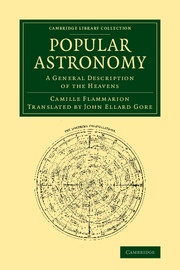
Popular Astronomy
- A General Description of the Heavens
-
- Published online:
- 05 November 2014
- Print publication:
- 13 February 2014
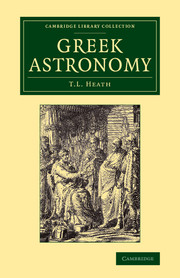
Greek Astronomy
-
- Published online:
- 05 November 2014
- Print publication:
- 20 March 2014
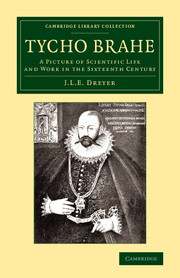
Tycho Brahe
- A Picture of Scientific Life and Work in the Sixteenth Century
-
- Published online:
- 05 November 2014
- Print publication:
- 13 February 2014
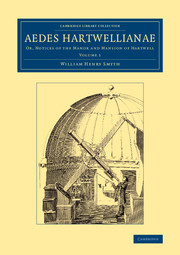
Aedes Hartwellianae
- Or, Notices of the Manor and Mansion of Hartwell
-
- Published online:
- 05 October 2014
- Print publication:
- 20 February 2014
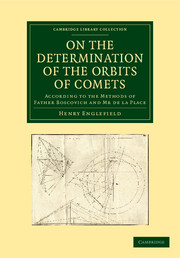
On the Determination of the Orbits of Comets
- According to the Methods of Father Boscovich and Mr de la Place
-
- Published online:
- 05 October 2014
- Print publication:
- 27 June 2013
- First published in:
- 1793

Astronomie populaire
- Description générale du ciel
-
- Published online:
- 05 October 2014
- Print publication:
- 20 March 2014

Aedes Hartwellianae
- Addenda to the Aedes Hartwellianae
-
- Published online:
- 05 October 2014
- Print publication:
- 20 February 2014
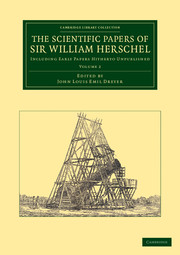
The Scientific Papers of Sir William Herschel
- Including Early Papers Hitherto Unpublished
-
- Published online:
- 05 October 2014
- Print publication:
- 05 September 2013
- First published in:
- 1912
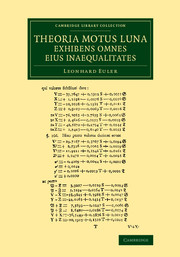
Theoria motus lunae exhibens omnes eius inaequalitates
- In additamento hoc idem argumentum aliter tractatur simulque ostenditur quemadmodum motus lunae cum omnibus inaequalitatibus innumeris aliis modis repraesentari atque ad calculum revocari possit
-
- Published online:
- 05 October 2014
- Print publication:
- 02 January 2014
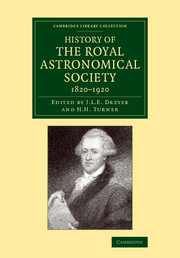
History of the Royal Astronomical Society, 1820-1920
-
- Published online:
- 05 October 2014
- Print publication:
- 20 March 2014

The Moon
- Considered as a Planet, a World, and a Satellite
-
- Published online:
- 05 October 2014
- Print publication:
- 05 September 2013

The Scientific Papers of Sir William Herschel
- Including Early Papers Hitherto Unpublished
-
- Published online:
- 05 October 2014
- Print publication:
- 05 September 2013
- First published in:
- 1912
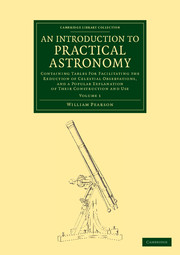
An Introduction to Practical Astronomy
- Containing Tables for Facilitating the Reduction of Celestial Observations, and a Popular Explanation of their Construction and Use
-
- Published online:
- 05 October 2014
- Print publication:
- 05 September 2013
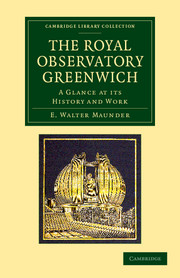
The Royal Observatory Greenwich
- A Glance at its History and Work
-
- Published online:
- 05 October 2014
- Print publication:
- 22 August 2013
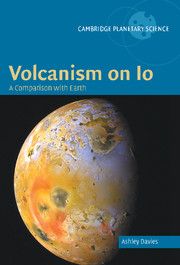
Volcanism on Io
- A Comparison with Earth
-
- Published online:
- 05 October 2014
- Print publication:
- 09 August 2007
Prologue
-
- Book:
- The Scientific Exploration of Venus
- Published online:
- 05 September 2014
- Print publication:
- 22 September 2014, pp xiii-xvi
-
- Chapter
- Export citation
Part III - Plans and visions for the future
-
- Book:
- The Scientific Exploration of Venus
- Published online:
- 05 September 2014
- Print publication:
- 22 September 2014, pp 235-236
-
- Chapter
- Export citation
